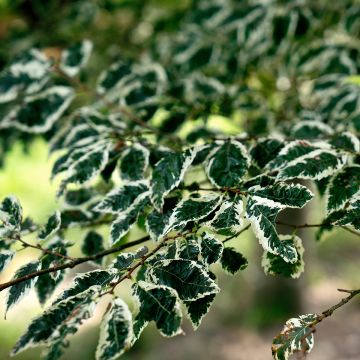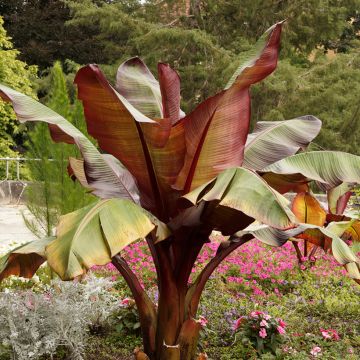

Zelkova serrata Green Vase


Zelkova serrata Green Vase


Zelkova serrata Green Vase
Zelkova serrata Green Vase
Zelkova serrata Green Vase (Flekova)
Japanese Zelkova, Siberian Elm, Saw-leaf Zelkova
Superb tree that tolerates alkaline soil (pH 7.8 in my case). Growth of 40cm (16in) per year for the past 6 years. Exceptional colours in October, especially this year. I have 6 zelkovas, the first one planted 8 years ago. None of them have contracted "graphiose" while a nearby elm has been affected. The Z. Green vase has a beautiful habit and a trunk that is not so short, measuring 4m (13ft) before the branches explode.
jean paul, 09/11/2015
Special offer!
Receive a €20 voucher for any order over €90 (excluding delivery costs, credit notes, and plastic-free options)!
1- Add your favorite plants to your cart.
2- Once you have reached €90, confirm your order (you can even choose the delivery date!).
3- As soon as your order is shipped, you will receive an email containing your voucher code, valid for 3 months (90 days).
Your voucher is unique and can only be used once, for any order with a minimum value of €20, excluding delivery costs.
Can be combined with other current offers, non-divisible and non-refundable.
Why not try an alternative variety in stock?
View all →This plant carries a 24 months recovery warranty
More information
We guarantee the quality of our plants for a full growing cycle, and will replace at our expense any plant that fails to recover under normal climatic and planting conditions.
Would this plant suit my garden?
Set up your Plantfit profile →
Description
The Zelkova serrata 'Green Vase' is a variety of Siberian Elm that is interesting for its natural resistance to Dutch Elm disease and its more modest size, which it owes to a dense and spreading semi-open crown, elegantly carried on a low branching. The tree is also remarkable for its autumn foliage in shades of gold, bronze, and orange. With a relatively fast growth, this elm is a beautiful shade tree for large gardens. It will thrive in cool, humus-rich, and clayey soils.
The Zelkova serrata 'Green Vase' ('Flekova') is a horticultural variety selected in 1983 in the USA. Its wild ancestor, the Siberian Elm, is native to the Caucasus. 'Green Vase' is a beautiful deciduous tree, perfectly hardy, still little cultivated in our garden. The habit of this variety is majestic, its short trunk branches relatively low, into several upright branches. The crown, both dense and spreading, widens over time. The trunk has a decorative, smooth grey bark, peeling to reveal a brown-orange sub-bark. With reasonably fast growth, the Zelkova 'Green Vase' reaches about 15-16 m (49-52ft) in height and 10-11 m (33-36ft) in width. Its branches bear alternate, petiolate, finely pointed, toothed leaves, dark green in colour, turning to golden yellow, orange, and bronze in autumn before falling. The inconspicuous green flowering occurs in April. Common Elms (Ulmus campestris) have been decimated by Dutch Elm disease, a fungal disease caused by a fungus transmitted by a beetle called the Elm Bark Beetle. The Zelkova serrata 'Green Vase', belonging to the same family, is naturally resistant to this disease.
The Zelkova Green Vase is a beautiful shade or avenue tree, best suited for large open spaces. Prune in winter to balance the branches. It can be planted as a specimen tree, along a main thoroughfare, or in a grove. It can be paired with a red maple, a lime tree, or a horse chestnut. This plant can also be trained as a bonsai.
Report an error about the product description
Zelkova serrata Green Vase in pictures




Plant habit
Flowering
Foliage
Botanical data
Zelkova
serrata
Green Vase (Flekova)
Ulmaceae
Japanese Zelkova, Siberian Elm, Saw-leaf Zelkova
Cultivar or hybrid
Other Zelkova
View all →Planting and care
The best time to plant the Zelkova serrata 'Green Vase' is in autumn. It should be planted in a well-prepared soil that is deep, moist, humus-rich to clayey, and fertile. The plant should be in a sunny or semi-shaded area, protected from direct sunlight and strong winds. It cannot grow in soils that have a high limestone content. During the first summers, water and mulch the plant regularly. Prune the branches in winter to maintain balanced growth. The plant is resistant to Dutch elm disease and can grow up to 18m (59ft) tall, so it's best suited for open and spacious areas.
Planting period
Intended location
Care
Planting & care advice
-
, onOrder confirmed
Reply from on Promesse de fleurs
Similar products
Haven't found what you were looking for?
Hardiness is the lowest winter temperature a plant can endure without suffering serious damage or even dying. However, hardiness is affected by location (a sheltered area, such as a patio), protection (winter cover) and soil type (hardiness is improved by well-drained soil).

Photo Sharing Terms & Conditions
In order to encourage gardeners to interact and share their experiences, Promesse de fleurs offers various media enabling content to be uploaded onto its Site - in particular via the ‘Photo sharing’ module.
The User agrees to refrain from:
- Posting any content that is illegal, prejudicial, insulting, racist, inciteful to hatred, revisionist, contrary to public decency, that infringes on privacy or on the privacy rights of third parties, in particular the publicity rights of persons and goods, intellectual property rights, or the right to privacy.
- Submitting content on behalf of a third party;
- Impersonate the identity of a third party and/or publish any personal information about a third party;
In general, the User undertakes to refrain from any unethical behaviour.
All Content (in particular text, comments, files, images, photos, videos, creative works, etc.), which may be subject to property or intellectual property rights, image or other private rights, shall remain the property of the User, subject to the limited rights granted by the terms of the licence granted by Promesse de fleurs as stated below. Users are at liberty to publish or not to publish such Content on the Site, notably via the ‘Photo Sharing’ facility, and accept that this Content shall be made public and freely accessible, notably on the Internet.
Users further acknowledge, undertake to have ,and guarantee that they hold all necessary rights and permissions to publish such material on the Site, in particular with regard to the legislation in force pertaining to any privacy, property, intellectual property, image, or contractual rights, or rights of any other nature. By publishing such Content on the Site, Users acknowledge accepting full liability as publishers of the Content within the meaning of the law, and grant Promesse de fleurs, free of charge, an inclusive, worldwide licence for the said Content for the entire duration of its publication, including all reproduction, representation, up/downloading, displaying, performing, transmission, and storage rights.
Users also grant permission for their name to be linked to the Content and accept that this link may not always be made available.
By engaging in posting material, Users consent to their Content becoming automatically accessible on the Internet, in particular on other sites and/or blogs and/or web pages of the Promesse de fleurs site, including in particular social pages and the Promesse de fleurs catalogue.
Users may secure the removal of entrusted content free of charge by issuing a simple request via our contact form.
The flowering period indicated on our website applies to countries and regions located in USDA zone 8 (France, the United Kingdom, Ireland, the Netherlands, etc.)
It will vary according to where you live:
- In zones 9 to 10 (Italy, Spain, Greece, etc.), flowering will occur about 2 to 4 weeks earlier.
- In zones 6 to 7 (Germany, Poland, Slovenia, and lower mountainous regions), flowering will be delayed by 2 to 3 weeks.
- In zone 5 (Central Europe, Scandinavia), blooming will be delayed by 3 to 5 weeks.
In temperate climates, pruning of spring-flowering shrubs (forsythia, spireas, etc.) should be done just after flowering.
Pruning of summer-flowering shrubs (Indian Lilac, Perovskia, etc.) can be done in winter or spring.
In cold regions as well as with frost-sensitive plants, avoid pruning too early when severe frosts may still occur.
The planting period indicated on our website applies to countries and regions located in USDA zone 8 (France, United Kingdom, Ireland, Netherlands).
It will vary according to where you live:
- In Mediterranean zones (Marseille, Madrid, Milan, etc.), autumn and winter are the best planting periods.
- In continental zones (Strasbourg, Munich, Vienna, etc.), delay planting by 2 to 3 weeks in spring and bring it forward by 2 to 4 weeks in autumn.
- In mountainous regions (the Alps, Pyrenees, Carpathians, etc.), it is best to plant in late spring (May-June) or late summer (August-September).
The harvesting period indicated on our website applies to countries and regions in USDA zone 8 (France, England, Ireland, the Netherlands).
In colder areas (Scandinavia, Poland, Austria...) fruit and vegetable harvests are likely to be delayed by 3-4 weeks.
In warmer areas (Italy, Spain, Greece, etc.), harvesting will probably take place earlier, depending on weather conditions.
The sowing periods indicated on our website apply to countries and regions within USDA Zone 8 (France, UK, Ireland, Netherlands).
In colder areas (Scandinavia, Poland, Austria...), delay any outdoor sowing by 3-4 weeks, or sow under glass.
In warmer climes (Italy, Spain, Greece, etc.), bring outdoor sowing forward by a few weeks.


















































